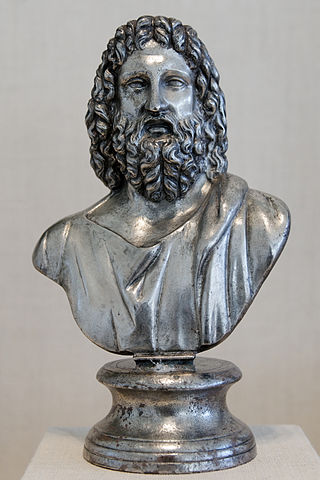See also
- Augustus Sol Invictus (born c. 1983), former Libertarian, alt-right Republican candidate for U.S. Senate in Florida
- Elagabalus (deity), a Syrian sun god
- Mithraism
- Sol (disambiguation)
Sol Invictus is a Roman god identified with Sol (the solar deity in Ancient Roman religion).
Sol Invictus may also refer to:

A solar deity or sun deity is a deity who represents the Sun, or an aspect of it. Such deities are usually associated with power and strength. Solar deities and Sun worship can be found throughout most of recorded history in various forms. The Sun is sometimes referred to by its Latin name Sol or by its Greek name Helios. The English word sun derives from Proto-Germanic *sunnǭ.

The Battle of the Milvian Bridge took place between the Roman Emperors Constantine I and Maxentius on 28 October 312 AD. It takes its name from the Milvian Bridge, an important route over the Tiber. Constantine won the battle and started on the path that led him to end the Tetrarchy and become the sole ruler of the Roman Empire. Maxentius drowned in the Tiber during the battle; his body was later taken from the river and decapitated, and his head was paraded through the streets of Rome on the day following the battle before being taken to Africa.
Elagabalus, Aelagabalus, Heliogabalus, or simply Elagabal was an Arab-Roman sun god, initially venerated in Emesa, Syria. Although there were many variations of the name, the god was consistently referred to as Elagabalus in Roman coins and inscriptions from AD 218 on, during the reign of emperor Elagabalus.
A cult is a religious or social group with socially deviant or novel beliefs and practices.

Sol Invictus was the official sun god of the late Roman Empire and a later version of the god Sol. The emperor Aurelian revived his cult in AD 274 and promoted Sol Invictus as the chief god of the empire. The main festival dedicated to him was the Dies Natalis Solis Invicti on 25 December, the date of the winter solstice in the Roman calendar. From Aurelian onward, Sol was of supreme importance, and often appeared on imperial coinage. He was often shown wearing a sun crown and driving a horse-drawn chariot through the sky. His prominence lasted until the emperor Constantine I established Christianity as the Imperial religion. The last inscription referring to Sol Invictus dates to AD 387, although there were enough devotees in the fifth century that the Christian theologian Augustine found it necessary to preach against them.
Sol or SOL may refer to:
Aion or AION may refer to:

Malakbel was a sun god worshipped in the ancient Syrian city of Palmyra, frequently associated and worshipped with the moon god Aglibol as a party of a trinity involving the sky god Baalshamin.

The Sun, as the source of energy and light for life on Earth, has been a central object in culture and religion since prehistory. Ritual solar worship has given rise to solar deities in theistic traditions throughout the world, and solar symbolism is ubiquitous. Apart from its immediate connection to light and warmth, the Sun is also important in timekeeping as the main indicator of the day and the year.
Invictus may refer to:
Ash is the solid remains of fire.

Sol is the personification of the Sun and a god in ancient Roman religion. It was long thought that Rome actually had two different, consecutive sun gods: The first, Sol Indiges, was thought to have been unimportant, disappearing altogether at an early period. Only in the late Roman Empire, scholars argued, did the solar cult re-appear with the arrival in Rome of the Syrian Sol Invictus, perhaps under the influence of the Mithraic mysteries. Publications from the mid 1990s have challenged the notion of two different sun gods in Rome, pointing to the abundant evidence for the continuity of the cult of Sol, and the lack of any clear differentiation – either in name or depiction – between the "early" and "late" Roman sun god.
The Roman cult of Mithras had connections with other pagan deities, syncretism being a prominent feature of Roman paganism. Almost all Mithraea contain statues dedicated to gods of other cults, and it is common to find inscriptions dedicated to Mithras in other sanctuaries, especially those of Jupiter Dolichenus. Mithraism was not an alternative to other pagan religions, but rather a particular way of practising pagan worship; and many Mithraic initiates can also be found worshipping in the civic religion, and as initiates of other mystery cults.
The Blade may refer to:
Dies natalis is Latin for "birthday, anniversary" and may refer to:

The Serapia or Sarapia was a Roman Imperial religious festival devoted to the Greco-Egyptian god Serapis. It is found as an official holiday on 25 April as late as the Calendar of Filocalus in 354 AD. In farmers' almanacs (menologia rustica) dating to the first half of the 1st century, the day was a sacrum or rite for Serapis along with Isis Pharia, "Isis of the Lighthouse (Pharos) of Alexandria".
Tiberius Julius Balbillus also known as Julius Balbillus and Aurelius Julius Balbillus was an Emesene aristocrat from the Emesene dynasty in Roman Syria who served as a priest of the cult of Elagabalus in Rome during the reigns of the Severan emperors Septimius Severus and Caracalla.
Titus Julius Balbillus was an Emesene aristocrat from the Emesene dynasty in Roman Syria who served as a priest of the cult of Elagabalus in Rome during the reigns of the Severan emperors Septimius Severus and Caracalla.

Sol Invictus is the seventh studio album by American rock band Faith No More, released on May 19, 2015. It was Faith No More's first studio album following 1997's Album of the Year, marking the longest gap between two studio albums in their career, and their first release on Reclamation Records. Sol Invictus was also the band's first album since 1992's Angel Dust to feature the same lineup as its predecessor.